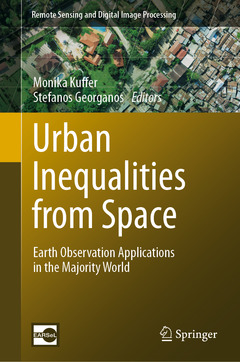Urban Inequalities from Space, 2024 Earth Observation Applications in the Majority World Remote Sensing and Digital Image Processing Series, Vol. 26
Coordonnateurs : Kuffer Monika, Georganos Stefanos

Chapter1. Introduction.- Part1: Global Analysis. chapter 2. Integration of remote and social sensing data reveals uneven quality of broadband connectivity across world cities.- Chapter3. Detecting inequalities from Earth Observation derived global societal variables.- Chapter4. The State of the Streets: Measurements of connectivity in the Atlas of Urban Expansion.- Chapter5. Urban and peri-urban? Investigation of the location of informal settlements using two databases.- Part2. Urban Deprivation. Chapter 6. Integration of Datasets Towards Slum Identification: Local Implementation of the IDEAMAPS Framework.- Chapter7. Putting the invisible on the map: Low-cost Earth Observation for mapping and characterizing deprived urban areas (‘slums’).- Chapter8. The Impact of Respondents' Background Towards Slum Conceptualisations and Transferability Measurement of Remote-Sensing Based Slum Detections. Case Study: Jakarta, Indonesia.- Chapter9.Part3: Temporal Analysis. Chapter10.Reconstructing 36 years of spatiotemporal dynamics of slums in Brazil by integrating EO and census data.- Chapter11. Assessing the impact of Addis Ababa’s successive urban policies on farmland loss, food insecurity and economic inequalities using earth observation data (1986 – 2022).- Part4. Socioeconomic Mapping and Ecosystem services. Chapter 12. A mixed method approach to estimate intra-urban distribution of GDP in conditions of data scarcity.- Chapter 13. Ecosystem Services from Space as Evaluation Metric of Human Well-being in Deprived Urban Areas of the Majority World.- Chapter14. Making Urban Slum Population Visible: Citizens and Satellites to reinforce slum censuses.
Monika Kuffer is an Associate Professor at the Faculty ITC (University of Twente, NL). Her research focuses on SDGs, poverty (deprivation), environment using Earth Observation, GIS, and AI. She (co)leads research projects on deprivation, e.g., IDEAtlas, SLUMAP, ONEKANA, ACCOUNT, IDEAMAPS. She is the Dutch representative of EARSeL (chair Developing Countries), EO Toolkit and JURSE Steering Committee.
Stefanos Georganos is an Associate Professor at Karlstad University. He does research in remote sensing, spatial epidemiology, and machine learning. He is interested in the use of geo-information to help address the UN Sustainable Development Goals. He is the Secretary-General of the European Association of Remote Sensing Laboratories (EARSeL) and co-chairperson of its Group on Developing Countries.
Date de parution : 05-2024
Ouvrage de 302 p.
15.5x23.5 cm
Thèmes d’Urban Inequalities from Space :
Mots-clés :
Artificial Intelligence; Earth Observation; Global South; Low and Middle Income Countries; Majority World; Machine Learning; Remote Sensing; Slums; Spatial Epidemiology; Sustainable Development Goals; Urban Sustainability; Urban Segregation; Urban Deprivation; Urban Health; Urban Resilience; Urban Poverty; Urban Growth; Urban Modelling; Urban Climate Vulnerability



